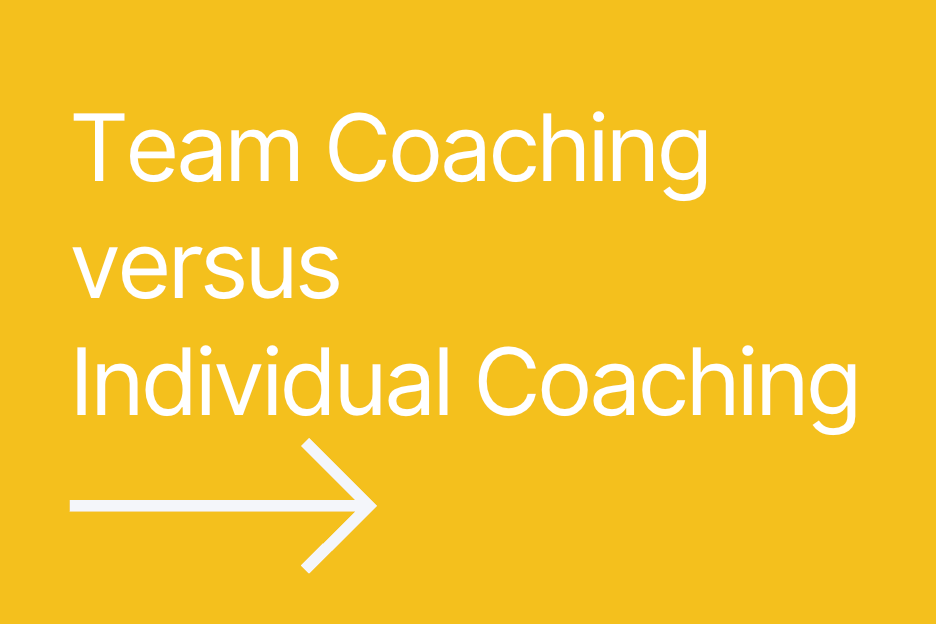
BLOG
Inspiration and news
Team Coaching verus Individual Coaching
You’ve invested in coaching for individuals, but something still isn’t shifting. This is where lots of organisations get stuck: it’s easy to assume the problem lies with an individual and to send them for coaching. But sometimes, the challenge isn’t one person, it’s in how the team works together (or doesn’t).
That’s where Team Coaching comes in.
How to spot whether you're dealing with a personal development need or something in the team dynamic.
You’ve invested in coaching for individuals, but something still isn’t shifting. Perhaps meetings are going round in circles, communication. feels clunky, decisions are slow, people aren’t doing what they say they will, and there may be tension in the air, but no one’s naming it.
So what’s the real issue? And what do you do now?
This is where lots of organisations get stuck: it’s easy to assume the problem lies with an individual and to send them for coaching. But sometimes, the challenge isn’t one person, it’s systemic. It’s something in how the team works together (or doesn’t).
What Individual Coaching Does Brilliantly
Stepping into a new role, tackling imposter syndrome, and adjusting to a new level of responsibility.
Developing confidence with giving feedback, difficult conversations, influencing, or strategic thinking.
Working through personal blocks like conflict avoidance or perfectionism.
Self-Awareness and EQ – Deepening reflection and emotional intelligence.
How to spot when Individual Coaching isn’t enough
The Revolving Door Problem - your leaders have been coached on similar issues, but the patterns repeat. It’s not them. It’s the system they’re in.
The Post-Coaching Plateau - Someone returns energised from coaching, but nothing changes. Their insight doesn’t stick because the team’s culture and habits haven’t changed.
The Invisible Stakeholder Trap - People make decisions without input from the right people. Coaching might help one person ask better questions, but it won’t fix the wider issue of unclear stakeholder engagement.
The Accountability Gap - People hesitate to call things out or challenge one another. Assertiveness coaching won’t help if the team hasn’t built psychological safety.
Competing Priorities, Constantly - Each person is doing their job well, but they’re heading in different directions. The team hasn’t agreed on what success looks like together.
What Team Coaching Builds That Individual Coaching Can’t
When the root causes are systemic, team coaching focuses on the collective, not just the individuals. Here’s what that can unlock:
Stakeholder-Focused Thinking - Teams get clearer on who they serve (internally and externally) and align around what their stakeholders truly need. Instead of each person building their shared stakeholder map, the team co-creates one together.
Joined-Up Decisions and Priorities - Team coaching surfaces how decisions are made (or not). It helps the team agree on how to prioritise, who decides what, and where alignment is needed, so there’s more clarity and less second-guessing.
Honest, Constructive Dialogue - Instead of avoiding the hard conversations, teams learn how to speak openly and disagree productively. This builds trust and psychological safety and gives people shared tools and language for navigating tension.
Collective Learning and Adaptability - Teams need space to reflect together—not just individually. Coaching encourages habits of reflection, experimentation, and shared learning that help the team improve how they work over time.
Shared Leadership and Collaboration - It’s not always about who’s in charge. It’s about flexing leadership based on strengths, context and what’s needed. Team coaching helps teams move from hub and spoke leadership to shared responsibility.
Integrating Individual and Team Coaching
The most powerful transformation happens when individual and team coaching work together strategically:
Individual coaching to ensure each team member has the personal foundation for effective collaboration
Team coaching to build collective capability and address systemic issues,
Individual coaching to help leaders integrate new team practices into their personal leadership approach
One size does not fit all
The question isn't whether individual or team coaching is better; it's about discovering which is right for the the challenge, the individuals and the team.
The most successful organisations I work with treat individual and team coaching as complementary capabilities in their leadership development toolkit. They invest in both, but deploy them strategically based on an accurate diagnosis of what's really needed.
Not Sure What You Need - I Can Help
If you’re not sure whether the issue sits with one person or the team as a whole, I can help.
My work often begins with a short discovery phase: a series of interviews, a team diagnostic, or a workshop to help you understand what’s really going on. From there, we can clarify whether individual coaching, team coaching, or a combination of both will move things forward.
Learn more about how I support Team Effectiveness >
Discover how I support Leaders and Individuals through Coaching >
Or get in touch to start a conversation about what might be possible for your team.
Email: polly@pollyrobinson.co.uk or call 07966 475195.


